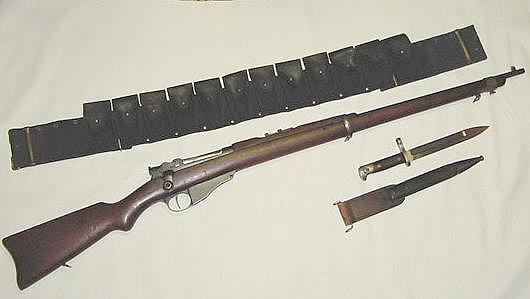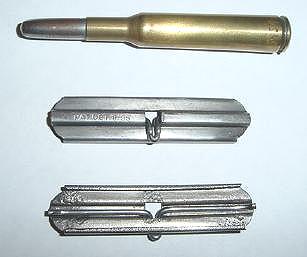


The Lee has what is frequently referred to as a straight-pull action.
In fact, the action is more properly a camming action in which pulling
the bolt caused a the bolt to rock, freeing a stud from the receiver and
unlocking the bolt. The cartridge used by the weapon was the smallest cartridge
adopted by the U.S. military up to that time.
Acut-away view of the mechanism
The ammunition used for the Lee utilized smokeless powder, offering a definite advantage over the "trapdoor" rifle. Shell casings were automatically extracted from the weapon.
One disadvantage of the weapon was that, when the magazine still
had ammunition in it, the gun could not be used for firing single shots.
A second problem was severe erosion of the bore because of the powder used
in the weapon's cartridges.

| Action: | Straight pull bolt action rapid-fire breech-loader | |
|---|---|---|
| Total length: | 47.75 inches | |
| Length of barrel: | 28 inches | |
| Rifling: | 6 grooves, making one turn in 6.5 inches. | |
| Weight: | 8.32 pounds | |
| Ammunition: | 6mm rimless, in five round clips | |
| Charge: | 33 grains of smokeless powder | |
| Weight of cartridge: | 332 grains | |
| Weight of projectile: | 135 grains | |
| Muzzle Velocity: | 2,460 feet per second at 60 feet from the muzzle. This gave the | |
| weapon the ability to penetrate 3/8 inch steel boiler plate at 100 feet. | ||
| Bayonet: | Knife-type, 8.25" long |
Gluckman, Arcadi, United States Muskets, Rifles and Carbines. Buffalo: Otto Ulbrich Co., Inc., 1948.
Howser, Doug (Image of rifle with belt and bayonet, and image of ammuniton).
Kirkland, K. D., America's Premier Gunmakers: Winchester, New York: Exeter Books, 1989.
Schreier, Philip, "The Guns of the Spanish American War," Military
Classics Illustrated (Los Angeles: Emap USA, 2001).

